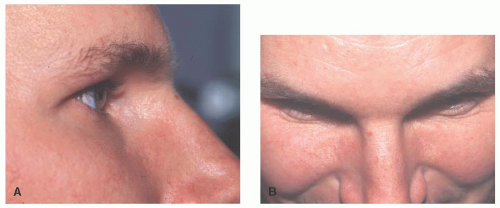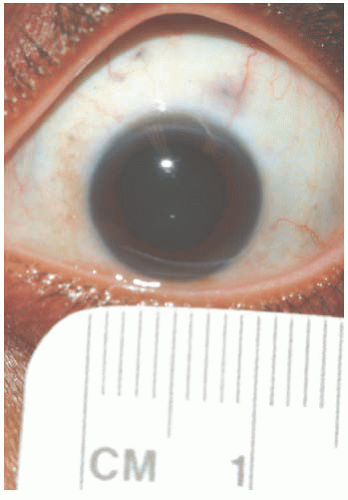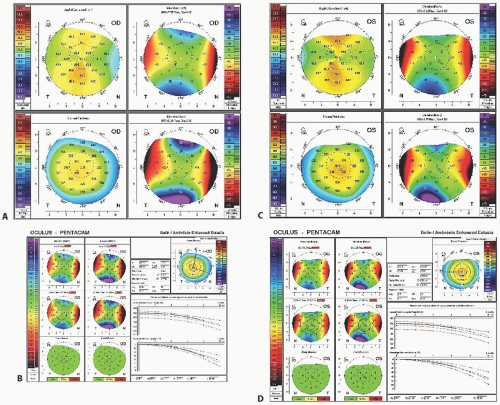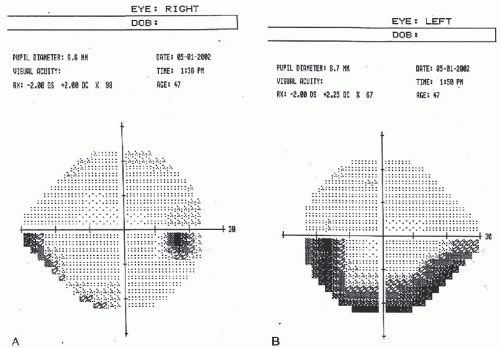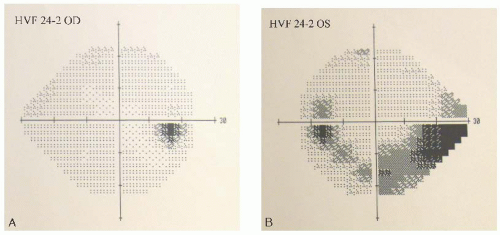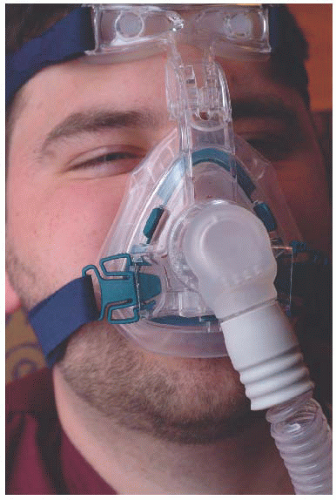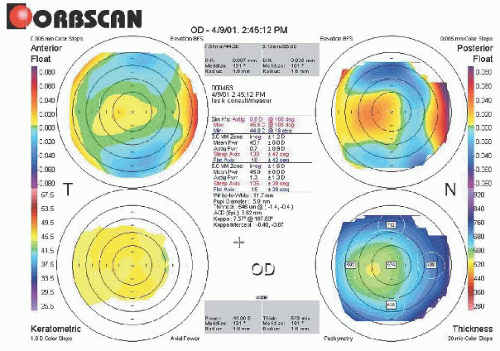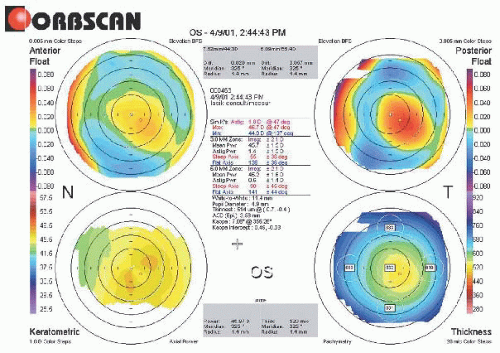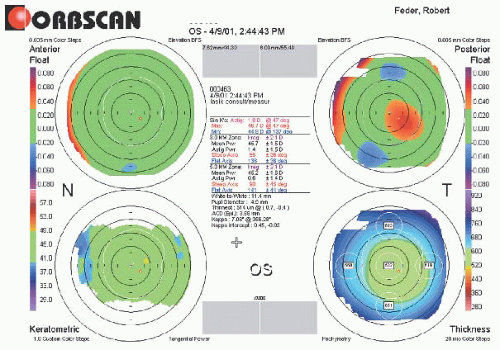factor causing postoperative nighttime glare and haloes. Many surgeons use the largest treatment zone that anatomical constraints will allow regardless of pupil size. Some accomplished surgeons do not even measure pupil size. Other surgeons prefer to tailor the treatment zone to the pupil size among other factors. Another example of a management change is that over time many surgeons have found no difference in night vision with either a 6.0- or 6.5-mm treatment zone as long as a blend zone to at least 8.0 mm is performed. They prefer to use the smaller treatment zone to conserve stromal tissue. Finally, there has been a heightened sensitivity about avoiding ectasia, and to that end surgeons are more conservative about preserving the RSB. While 250 µm was considered adequate thickness in years past, some surgeons now routinely prefer 275 µm or even 300 µm; and some are more likely to advise against LASIK for even minor topography abnormalities. While the scenarios presented in these cases are timeless, opinions about the optimal management strategies should be expected to change over time.
W | OD – 6.25 20/20+ OS – 6.25 20/20- | Uncorrected Va 20/400 OU | |||
M | OD – 5.50 + 0.50 × 40° 20/15 OS – 5.25 20/15- | ||||
C | OD – 5.25 20/15 OS – 4.75 20/15- | ||||
K | OD 44.50 × 180°/44.87 × 90° OS 44.50 × 180°/44.75 × 90° | ||||
Pachymetry OD 541 µm OS 531 µm | Topography No cone OU | Scotopic Pupils OD 5.0 mm OS 5.0 mm | |||
Surgical Plan | ||||||||||||||||||||||||||||||||
|---|---|---|---|---|---|---|---|---|---|---|---|---|---|---|---|---|---|---|---|---|---|---|---|---|---|---|---|---|---|---|---|---|
|
1 | Always use the cycloplegic refraction before making the nomogram adjustment in calculating the ablation depth. |
2 | Using an ablation zone slightly larger than the scotopic pupil minimizes tissue removal. Be aware that there is a trend toward relying less on pupil size to determine treatment zone, given the lack of scientific evidence to support pupil size as a factor related to postoperative night vision disturbance. |
3 | A larger flap is desirable in case a retreatment requires a larger treatment zone. However, when the flap edge is near the limbus, the flap may be more difficult to relift. |
4 | Warn the patient overcorrected in spectacles or glasses about the possibility of a slower postoperative visual recovery. |
W | OD – 10.25 + 1.25 × 4° 20/25- OS – 10.25 + 0.75 × 150° 20/30- | Uncorrected Va CF 3′ CF 3′ | |||
M | OD – 9.50 + 0.50 × 180° 20/15- OS – 9.75 + 0.75 × 135° 20/15 | ||||
C | OD – 9.75 + 0.50 × 160° 20/15-Vertex distance 12 mm OS – 9.50 + 0.50 × 120° 20/20 Vertex distance 12 mm | ||||
K | OD 44.87 × 90°/44.50 × 180° OS 43.87 × 40°/44.50 × 130° | ||||
Pachymetry OD 564 µm OS 555 µm | Topography Against-the-rule astigmatism OU; no cone OU | Scotopic Pupils OD 5.0 mm OS 5.0 mm | |||
Surgical Plan | ||||||||||||||||||||||||||||
|---|---|---|---|---|---|---|---|---|---|---|---|---|---|---|---|---|---|---|---|---|---|---|---|---|---|---|---|---|
|
1 | Make certain the patient will have enough RSB for retreatment and will have adequate corneal curvature to support good visual function. |
2 | Always use the non-nomogram-adjusted spherical equivalent to calculate the ablation depth. Do not rely on the ablation depth calculated by the laser for conventional LASIK. |
3 | Measure pachymetry intraoperatively. Do not rely on a central pachymetry measurement made on a different day. |
4 | Do not compromise on patient safety. Consider alternatives to LASIK when necessary. Straight talk with the patient is always the best approach. |
W | OD – 4.25 + 1.00 × 78° OS – 2.50 + 0.50 × 125° | Uncorrected Va 20/400 20/200 | |||
M | OD – 4.75 + 1.25 × 70° 20/20 OS – 3.25 + 0.75 × 135° 20/20 | ||||
C | OD – 5.00 + 1.50 × 75° 20/20 OS – 3.00 + 0.50 × 125° 20/20 | ||||
K | OD 41.00 × 170°/43.00 × 80° OS 42.12 × 35°/43.75 × 125° | ||||
Pachymetry OD 548 µm OS 552 µm | Topography Regular astigmatism OU | Scotopic Pupils OD 6.9 mm OS 6.8 mm | |||
Surgical Plan | ||||||||||||||||||||||||||||||||||||||||
|---|---|---|---|---|---|---|---|---|---|---|---|---|---|---|---|---|---|---|---|---|---|---|---|---|---|---|---|---|---|---|---|---|---|---|---|---|---|---|---|---|
|
1 | Be sure that the patient has been out of RGPCLs long enough to allow the cornea to assume its normal shape. |
2 | Look for factors that could predispose a patient to postoperative dry eyes and pretreat the patient appropriately. |
3 | Treat a patient with rosacea with preoperative oral tetracycline and lid hygiene. |
4 | Consider wavefront-guided ablation if the wavefront-derived refraction is consistent with the manifest refraction and the patient demonstrates higher order aberrations (HOAs). |
W | OD – 2.50 20/20- OS – 2.50 20/20- | Uncorrected Va 20/200 20/200 | |||
M | OD – 3.75 + 1.25 × 87° 20/15 OS – 3.25 + 0.75 × 85° 20/15- | ||||
C | OD – 3.50 + 1.00 × 85° 20/15- OS – 3.25 + 0.75 × 90° 20/15 | ||||
K | OD 42.75 × 177°/43.75 × 87° OS 43.00 × 180°/44.00 × 90° | ||||
Pachymetry OD 513 µm OS 509 µm | Topography Regular with-the-rule astigmatism OU | Scotopic Pupils OD 7.0 mm OS 7.0 mm | |||
Surgical Plan | ||||||||||||||||||||||||||||
|---|---|---|---|---|---|---|---|---|---|---|---|---|---|---|---|---|---|---|---|---|---|---|---|---|---|---|---|---|
|
1 | Emphasize those risks that are relevant to a given patient based on the patient’s work and leisure activities. |
2 | Design the surgery to minimize those risks. In this case, use a treatment zone larger than the scotopic pupil, use the largest zone permissible given the anatomical constraints, and/or consider a custom treatment. |
W | OD -6.50 + 0.50 × 95 OS -6.25 + 0.50 × 85 | Uncorrected Va 20/400 OU | |||
M | OD -6.00 sphere OS -6.50 + 0.50 × 80 | ||||
C | OD -5.75 sphere OS -6.25 + 0.50 × 80 | ||||
K | OD 42.50 × 180/43.25 × 90 OS 42.50 × 180/43.25 × 90 | ||||
Pachymetry OD 556 µm OS 549 µm | Topography OD 0.75 D regular cyl at 90; normal elevation OS 1.00 D regular cyl at 80; normal elevation | Scotopic Pupils 6.0 mm OU | |||
Surgical Plan | |||||||
|---|---|---|---|---|---|---|---|
|
1 | Allergic conjunctivitis is a common cause for contact lens intolerance. Care should be taken to adequately treat the allergic conjunctivitis until the conjunctiva and ocular surface looks quiet. Attention should also be paid to avoid treating seasonal allergy patients during their high allergy season. |
2 | The Alcon WaveLight laser platform works well with the integrated SurgiVision DataLink program. The DataLink program uses the surgeon’s specific nomogram to adjust treatment parameters before entering this data into the laser. The entered data is therefore based upon analyzed outcomes from the surgeon’s specific databank. |
W | OD – 4.50 + 0.50 × 90° 20/25 OS – 4.75 + 0.75 × 90° 20/30 | Uncorrected Va 20/400 20/400 | |||
M | OD – 4.75 + 0.50 × 90° 20/20 OS – 5.25 + 0.75 × 85° 20/20 | ||||
C | OD – 4.75 + 0.50 × 90° 20/20 OS – 5.25 + 0.75 × 90° 20/20 | ||||
K | OD 40.50 × 90°/40.00 × 180° OS 41.50 × 90°/40.50 × 180° | ||||
Pachymetry OD 535 µm OS 540 µm | Topography Regular bow-tie OU | Scotopic Pupils 7.0 mm OU | |||
Surgical Plan | ||||||||||||||||||||||||||||
|---|---|---|---|---|---|---|---|---|---|---|---|---|---|---|---|---|---|---|---|---|---|---|---|---|---|---|---|---|
|
W | OD – 3.75 + 1.75 × 89°20/20+ OS – 4.75 + 2.00 × 81° 20/15 | Uncorrected Va CF 5′ CF 5′ | |||
M | OD – 3.75 + 1.75 × 100°20/15 OS – 4.50 + 2.00 × 90° 20/15 | ||||
C | OD – 3.75 + 2.00 × 100°20/15 OS – 4.50 + 2.00 × 85° 20/15- | ||||
K | OD 39.50/41.00 × 94° OS 39.12/41.37 × 94° | ||||
Pachymetry OD 550 µm OS 550 µm | Topography No cone OU | Scotopic Pupils OD 6.0 mm OS 6.0 mm | |||
is quite flat. If the cornea is very flat, for example, keratometry values <39.00 D, and the degree of correction is low, a surface ablation procedure is a consideration. In this case, there is ample tissue, which allows the surgeon the flexibility to choose a 160- or 180-µm plate on the Hansatome. The size of the treatment zone is selected to be slightly larger than the diameter of the scotopic pupil. A slightly deep-set eye would not pose a serious problem, particularly if the lids are lax and the palpebral fissure is wide. However, patients with deep-set eyes will be more challenging for beginning LASIK surgeons.
Surgical Plan | ||||||||||||||||||||||||||||||||
|---|---|---|---|---|---|---|---|---|---|---|---|---|---|---|---|---|---|---|---|---|---|---|---|---|---|---|---|---|---|---|---|---|
|
1 | Astigmatism reduces the ablation depth by decreasing the value of the spherical equivalent. |
2 | High astigmatism correction as part of a conventional myopic astigmatic correction may contribute to night vision issues. This is because of the smaller width of the minor axis of the astigmatic treatment zone. For astigmatism >2.00 D, the patient should be advised. |
3 | A larger microkeratome ring is required if the cornea is flat, and if very flat, avoid using a blade microkeratome. Either use the femtosecond laser for flap creation or do a surface ablation procedure. |
She was just chosen for this post and is leaving in 2 to 3 weeks and is anxious to proceed with evaluation and the surgery as soon as possible. She has done a lot of research on LASIK and is confident about basic understanding of the risks.
W | OD – 4.50 20/40 – HCL OD 20/20 OS – 4.50 20/25 – HCL OS 20/20 | Uncorrected Va CF 5′ CF 5′ | |||
M | OD – 3.75 + 0.50 × 90° 20/25 OS – 4.00 + 0.75 × 85° 20/25- | ||||
C | OD – 3.50 + 0.50 × 85° 20/30- OS – 4.00 + 0.75 × 85° 20/25 | ||||
K | OD 43.75 × 177°/44.25 × 87° OS 43.50 × 180°/44.00 × 90° | ||||
Pachymetry OD 554 µm OS 557 µm | Topography Regular with-the-rule astigmatism OU | Scotopic Pupils OD 5.0 mm OS 5.0 mm | |||
1 | Beware of the patient who is desperate for surgery, overly confident about the risks, and anxious to proceed. |
2 | Avoid surgery if the patient will not get adequate follow-up care. |
3 | Allow adequate time for the corneas to stabilize, particularly when the patient cannot be refracted to 20/20 and there is no other cause. |
W | OD – 1.50 + 0.50 × 8° 20/20+ OS – 2.75 20/20 + Add + 2.00 OU | Uncorrected Va 20/100 20/200 | |||
M | OD – 1.00 + 0.50 × 8° 20/20 OS – 2.75 20/20 | ||||
C | OD – 1.25 + 0.25 × 175° 20/15 OS – 2.75 20/15 – | ||||
K | OD 40.00 × 180°/41.50 × 90° OS 41.00 × 10°/41.75 × 100° | ||||
Pachymetry OD 573 µm OS 572 µm | Topography No cone OU | Scotopic Pupil OD 6.0 mm OS 6.0 mm | |||
treat the nondominant eye. A preoperative trial of monovision using a contact lens in the dominant eye is often helpful. Second, the corneal contour is relatively flat. Remember that there is an increased risk of a small flap or free cap when the corneal contour is flat. A larger ring is needed to ensure that the flap will be large enough to accommodate a larger treatment zone. Finally, the periorbital anatomy may pose a problem. Remember to check prominence of the brow, relative height of the palpebral fissure, lid laxity, and degree of enophthalmos in determining whether exposure will be adequate. If exposure is an issue, consider going with a more sturdy speculum such as the Murdock speculum (ASICO AE-183); going without a speculum and the standard ring; using a micro-ring, which has a smaller outer diameter; using a single-piece microkeratome such as the Amadeus or the Nidek, which creates a nasal hinge; or the femtosecond laser which does not depend on the translation of a blade across the cornea. One could also consider a surface ablation procedure. Adequate preoperative sedation can help achieve adequate exposure by relaxing periorbital muscles and reducing blepharospasm.
Surgical Plan | ||||||||||||||||||||||||||||||||
|---|---|---|---|---|---|---|---|---|---|---|---|---|---|---|---|---|---|---|---|---|---|---|---|---|---|---|---|---|---|---|---|---|
|
1 | Consider sequential rather than simultaneous treatment if the patient is of presbyopic age and the refractive error of the nondominant eye is suitable for near vision correction. |
2 | Consider the risk of inadequate flap diameter or free cap if the cornea is flat. |
3 | Flaps are more difficult to make if the eye is deep set. Remember the various treatment options available in this setting. Discuss the surface ablation option preoperatively. |
W | None | Uncorrected Va 20/25+ dist; 14 pt near 20/200 dist; 4 pt near | |||
M | OD – 0.25 + 0.50 × 180° 20/20 OS – 2.00 20/20 | ||||
C | OD pl + 0.50 × 180° 20/20 OS – 1.75 20/20- | ||||
K | OD 42.62 × 179°/42.00 × 89° OS 43.00 × 180°/43.00 × 90° | ||||
Pachymetry OD 520 µm OS 520 µm | Topography No evidence of keratoconus | Scotopic Pupils OD 5 mm OS 5 mm | |||
1 | Avoid refractive surgery in presbyopic patients who function well without glasses or contact lenses during work and leisure activities. |
2 | Motivation for refractive surgery does not make a patient a candidate for refractive surgery. |
3 | The preoperative evaluation is an opportunity to understand the patient’s motivations for surgery, determine if the patient will achieve a net gain from the surgery, and educate the patient. |
4 | A patient properly advised against surgery can be a potential referral source, while a patient made unhappy with surgery will usually speak negatively about the surgeon and the office. |
“lazy eye” OD as a child with no history of strabismus surgery or patching. She also has a history of corneal neovascularization OU. She wears SCL, 2-week disposables, but has tolerated RGP lenses in the past. The patient denies diplopia while wearing contact lenses. Currently, she uses no ocular medications.
W | OD – 6.25 + 1.00 × 96°20/20 OS – 6.25 + 0.25 × 179°20/30 | Uncorrected Va OD CF OS CF | |||
M | OD – 6.00 + 1.25 × 90°20/20+ OS – 7.25 20/15- | ||||
C | OD – 5.75 + 1.00 × 85° 20/15 OS – 6.75 20/15 | ||||
K | OD 44.75 × 7°/44.75 × 97° OS 44.50 × 3°/45.00 × 93° | ||||
Pachymetry OD 549 µm OS 547 µm | Topography OD regular astigmatism OS no cone | Scotopic Pupils OD 7.5 mm OS 7.5 mm | |||
should attempt to rule out previous herpes simplex disease or other source of chronic keratitis. The blepharitis in this case should be treated and controlled preoperatively and the lids reexamined prior to surgery.
Surgical Plan | ||||||||||||||||||||||||||||||||
|---|---|---|---|---|---|---|---|---|---|---|---|---|---|---|---|---|---|---|---|---|---|---|---|---|---|---|---|---|---|---|---|---|
|
1 | Perform a motility examination routinely. Abnormalities should be explained to the patient. Patients who are asymptomatic in contact lenses should do well unless significant anisometropia or distortion has developed that interferes with fusion. Any potential risks should be explained and documented in the chart. |
2 | When pannus or neovascularization is present, consider flap diameter and its implications. Balance the need to protect the peripheral cornea with the need to accommodate a large treatment zone. IntraLase, if available, can be helpful. |
3 | Treat blepharitis preoperatively and examine patient before surgery to be certain that the condition is controlled. |
W | OD – 6.50 + 2.25 × 115° OS – 5.50 + 2.00 × 85° | Uncorrected Va CF 5′ CF 5′ |
M | OD – 6.25 + 2.00 × 115° 20/20 OS – 5.75 + 2.50 × 80° 20/20 | |
WR | OD – 6.75 + 2.30 × 120° OS – 5.71 + 2.45 × 84° | |
C | OD – 6.50 + 2.25 × 120° 20/20 OS – 5.75 + 2.50 × 85° 20/20 | |
K | OD 43.00 × 35°/45.75 × 125° OS 42.75 × 175°/45.50 × 85° | |
Pachymetry OD 546 µm OS 548 µm | Topography Regular astigmatism OU | Scotopic Pupils OD 8.7 mm OS 8.8 mm |
1 | The CustomVue platform allows for adjustment of the treatment zone for patients with large pupils. Some surgeons use the largest feasible treatment zone regardless of pupil size. |
2 | The CustomVue treatment reduces the risk of night vision problems for patients at risk for such problems or in patients who would be bothered by these symptoms. It induces less new HOAs than many other excimer lasers. |
W | OD – 4.50 20/20- OS – 4.50 20/20- | Uncorrected Va CF 5′ CF 5′ |
M | OD – 4.75 + 0.75 × 87° 20/15 OS – 4.50 + 0.50 × 85° 20/15- | |
C | OD – 4.50 + 0.75 × 85° 20/15- OS – 4.25 + 0.50 × 85° 20/15 | |
K | OD 46.75 × 177°/47.25 × 87° OS 46.50 × 180°/47.00 × 90° | |
Pachymetry OD 504 µm OS 507 µm | Topography Regular with-the-rule astigmatism OU | Scotopic Pupils OD 7.5 mm OS 7.5 mm |
Surgical Plan | |||
Right Eye | Left Eye | Comments | |
The patient opts for PRK OU | |||
Ablation zone | 6.5 mm with blend | 6.5 mm with blend | VISX STAR S4 laser |
No nomogram correction for PRK (enter into VISX) | -4.50 + 0.75 × 85° | -4.25 + 0.50 × 85° | |
Ablation depth | 4.13 D × 15 µm/D = 62 µm + 8 µm = 70 µm | 60 µm + 8 µm = 68 µm | Discuss the risk of haze and the need for topical steroids postoperatively |
RSB | 504 µm -70 µm = 434 µm 434 µm | 507 µm – 68 µm = 439 µm 439 µm | |
1 | Recognize the special challenge posed by the patient with microcornea. |
2 | PRK remains an important keratorefractive option in selected cases. |
3 | The femtosecond laser is safer than the microkeratome in the patient with a small, steep cornea because it offers more control over the flap diameter. |
W | OD – 5.50 + 1.00 × 93° 20/15- OS – 4.50 + 0.50 × 75° 20/15 | Uncorrected Va 20/400 20/400 |
M | OD – 5.00 + 1.00 × 90° 20/15 OS – 4.50 + 0.50 × 75° 20/15 | |
C | OD – 5.00 + 1.00 × 90° 20/15 OS – 4.25 + 0.75 × 65° 20/15 | |
K | OD 42.00 × 180°/745.50 × 90° OS 42.25 × 180°/45.50 × 90° | |
Pachymetry OD 528 µm OS 537 µm | Topography OD + 3.5 D at 94° regular OS +3.0 D at 89° regular | Scotopic Pupils OD 7.5 mm OS 7.0 mm |
Surgical Plan | |||
Right Eye | Left Eye | Comments | |
Ring size | 9.5 mm | 9.5 mm | |
Plate size | 160 µm | 160 µm | Actual Hansatome flap often thinner than the plate |
Ablation zone | 6.5 mm with blend or custom | 6.5 mm with blend or custom | Pupils >6.5 mm 6.0 mm with blend can also be used |
Spherical equivalent (SE) | -4.50 D | -3.87 D | |
Calculations with nomogram correction (enter into VISX) | -4.50 D × 6% = 0.27 D -5.00 + 0.27 = -4.73 -4.73 + 1.00 × 090 | -3.87 D × 6% = 0.23 D -4.25 + 0.23 = -4.02 -4.02 + 0.75 × 065 | Reduce sphere of cycloplegic refraction by the calculated nomogram adjustment |
Ablation depth | 4.50 D × 15 µm/D = 68 µm+ 8 µm blend = 76 µm | 3.87 D × 15 µm/D = 58 µm + 8 µm blend = 66 µm | Calculate ablation depth using the non-nomogram-adjusted SE |
RSB | 528 µm – 160 µm – 76 µm = 292 µm >250 µm | 537 µm – 160 µm – 66 µm = 311 µm >250 µm | Intraoperative pachymetry is the most accurate way to determine RSB |
1 | A large treatment zone is preferable when the pupil diameter is large. However, some surgeons routinely use the largest zone that anatomical constraints will allow regardless of pupil size. |
2 | It is worthwhile to note disparities between refractive astigmatism and corneal astigmatism measured with topography and keratometry, but base the treatment on the refractive astigmatism. |
3 | Treat blepharitis and rosacea prior to surgery. |
W | OD -5.00 + 4.75 × 73° 20/20 OS -6.25 + 6.00 × 80° 20/25± | Uncorrected Va 20/80 20/80 | |
M | OD – 5.00 + 4.75 × 75° 20/20 OS – 5.50 + 4.00 × 75° 20/20 | ||
C | OD – 4.75 + 4.75 × 75° 20/15- OS -4.75 + 4.00 × 80° 20/20 | ||
K | OD 42.62 / 45.75 × 70° OS 42.62 / 45.75 × 70° | ||
Pachymetry OD 502 µm OS 506 µm | Topography OD See below OS See below | Scotopic Pupils OD 7.8 mm OS 7.6 mm | Dominant Eye OS |
49 µm OS. Nine months following surgery, the uncorrected acuity was 20/20+ OD and 20/25 OS with a refraction of plano OD and -0.50 + 0.50 × 145 OS. She noted some glare at night, but on balance was quite pleased.
1 | Careful analysis of corneal topography, power, elevation, and thickness, is especially important in a highly astigmatic patient to rule out signs of preexisting ectasia. |
2 | Highly astigmatic patients should be presented with realistic vision expectations and warned about possible nighttime visual symptoms. |
3 | Successful correction of high astigmatism has the potential to improve near as well as distance vision even in a young person. |
W | OD – 5.75 20/30- OS – 5.50 + 1.25 × 86° 20/20- | Uncorrected Va OD CF 5′ OS CF 5′ |
M | OD – 5.50 + 0.50 × 65° 20/20+ OS – 5.25 + 1.00 × 92° 20/15- | |
C | OD – 5.25 + 0.75 × 75° 20/20+ OS – 5.25 + 1.25 × 92° 20/15- | |
K | OD 43.12 × 175°/44.00 × 85° OS 42.62 × 180°/43.75 × 90° | |
Pachymetry OD 550µ m OS 550 µm | Topography No cone OU | Scotopic Pupils OD 6.5 mm OS 7.0 mm |
a history of dry eye even when specifically asked. The clinician must discern whether tear deficiency is present and whether it might affect the surgical outcome. Several of the factors in this case should signal a potential problem with tear function postoperatively. First, sarcoidosis can cause reduction in lacrimal gland tear production. This may have been a factor causing her contact lens intolerance. Second, tear deficiency is more common in middleaged and older women. Third, she is using oral decongestants, which can dry the mucous membranes. The history of the flu might suggest that the consultation is taking place during winter when the ambient humidity is decreased. Next, the wide fissure and prominent globes will undoubtedly increase the likelihood of evaporation from the ocular surface. Finally, the patient works as a copyeditor, requiring her to read all day, further drying the eyes due to exposure.
Surgical Plan | |||
Right Eye | Left Eye | Comments | |
Considerations | Evaluate for dry eye, consider punctal plugs or other measures, and reevaluate. Proceed only if surface is healthy | ||
Ring size | 9.5 mm | 9.5 mm | Hansatome |
Plate size | 160 or 180 µm | 160 or 180 µm | Actual flap thickness may be thinner or thicker |
Ablation zone | 6.0 or 6.5 mm with blend or custom | 6.0 or 6.5 mm with blend or custom | VISX STAR S4 Pupils >6.5 mm |
Spherical equivalent | -4.88 D | -4.63 D | |
Calculations using nomogram adjustment (enter into VISX laser) | 4.88 × 8% = 0.39 -5.25 + 0.39 = -4.86 -4.86 + 0.75 × 75° | 4.63 × 8% = 0.37 -5.25 + 0.36 = -4.89 -4.89 + 1.25 × 92° | Some surgeons use cylinder axis from cycloplegic refraction, some use an axis midway between C and M, some use the axis of the M |
Ablation depth | 4.88 D × 15 µm/D (Use 12 µm/D for a 6.0 mm ablation zone) = 73 µm + 8 µm (for blend) = 81 µm | 4.63 D × 15 µm/D (Use 12 µm/D for a 6.0 mm ablation zone) = 70 µm + 8 µm (for blend) = 78 µm | Use non-nomogram-adjusted SE to calculate ablation depth |
RSB Intraoperative pachymetry is recommended for RSB calculation | 550 µm – 160 µm -81µm = 309 µm >250 µm | 550 µm – 160 µm – 78 µm = 302 µm >250 µm | If Hansatome flap is thinner than 160 µm, the RSB will be greater |
1 | Complete past medical and ocular history is an important part of the preoperative evaluation. |
2 | Be suspicious for a tear deficiency condition and evaluate properly. Treat the dry eye and reevaluate. Operate only if the surface condition can be normalized. Remember that even if it can, the patient may still experience dry eye symptoms for months or years after surgery. |
3 | Discuss this condition with the patient and document the discussion in the chart. |
W | OD – 6.50 + 1.25 × 4° 20/25- OS – 6.25 + 0.75 × 103° 20/30- | Uncorrected Va CF 5′ CF 5′ |
M | OD – 5.25 + 1.00 × 12° 20/15- OS – 6.00 + 1.50 × 128° 20/15 | |
C | OD – 5.00 + 1.00 × 13° 20/15- OS – 5.75 +1.50 × 130° 20/20± | |
K | OD 43.87 × 175°/44.00 × 85° OS 43.87 × 20°/44.75 × 110° | |
Pachymetry OD 506 µm OS 508 µm | Topography Regular with-the-rule astigmatism OU | Scotopic Pupils OD 6.5 mm OS 7.0 mm |
function was normal. The slit-lamp examination was normal. The IOP was 20 mmHg by applanation OU. The cup-to-disc ratio was 0.3 OU and the rest of the fundus examination was normal. Old records were obtained and IOPs had been measured in the high 20s by applanation. Visual fields were obtained and were normal. Stereo disc photographs were obtained for baseline.
Surgical Plan | |||
Right Eye | Left Eye | Comments | |
IntraLase flap diameter | 9.0 mm | 9.0 mm | Larger flap diameter in case retreatment needed |
IntraLase flap thickness (actual flap thickness variance less with laser than microkeratome) | 110 µm | 110 µm | IntraLase usually creates a flap not greater than 120 µm when set at 110 µm; preferred for patient with thin cornea |
Ablation zone | 6.5 mm with blend (6.0 mm with blend is an option to conserve tissue) | 6.5 mm with blend (6.0 mm with blend is an option to conserve tissue) | VISX STAR S4 |
Calculations with nomogram correction (enter into VISX) | -4.50 D × 9% = 0.41 -5.00 + 0.41 = -4.59 -4.59 + 1.00 × 13° | -3.00 D × 9% = 0.27 -3.75 + 0.27 = -3.48 -3.48 + 1.50 × 130° | Myopic sphere OS is reduced by 2.00 D to achieve monovision |
Ablation depth | 4.50 D × 15 µm/D = 68 µm | 3.00 D × 15 µm/D = 45 µm | |
RSB | 68 µm + 8 µm blend = 76 µm 506 µm – 120 µm – 76 µm = 310 µm >250 µm | 45 µm + 8 µm blend = 53 µm 508 µm – 120 µm – 53 µm = 335 µm >250 µm | Especially important to measure the bed thickness to be certain adequate room for ablation |
1 | Monovision treatment is good for presbyopic patients who have previously been successful with monovision. The potential impact on fusion and night vision should be explained preoperatively. |
2 | A glaucoma suspect patient may have LASIK, but baseline fields and stereo disc photos are important to establish a baseline. IOP measurements are inaccurate after myopic LASIK. |
3 | Postoperative dry eye is a concern, particularly in women over 50 years of age. Increased tear evaporation associated with lid retraction, lagophthalmos, and low ambient humidity can increase the risk of postoperative dry eye symptoms. |
W | OD – 5.25 + 2.00 × 98° 20/25 OS – 5.25 + 2.25 × 67° 20/30- | Uncorrected Va OD CF OS CF |
M | OD – 5.50 + 2.00 × 100° 20/20- OS – 5.25 + 2.00 × 75° 20/20- | |
C | OD – 5.25 + 2.25 × 90° 20/15- OS – 5.25 + 2.25 × 70° 20/20+ | |
K | OD 45.62 × 175°/48.25 × 85° OS 46.00 × 170°/47.00 × 80° | |
Pachymetry OD 489 µm OS 495 µm | Topography No cone | Scotopic Pupils OD 5.0 mm OS 5.0 mm |
Surgical Plan: LASIK and PRK | |||
Right Eye | Left Eye | Comments | |
Ring size | N/A for PRK 8.5 mm for LASIK | N/A for PRK 8.5 mm for LASIK | PRK requires 7.0-mm epithelial debridement |
Ablation zone | 6.0 mm | 6.0 mm | Pupils <6.5 mm |
Spherical equivalent | -4.125 | -4.125 | |
Calculations for LASIK with nomogram correction (enter into VISX) | 4.125 × 8% = 0.33 -5.25-0.33 = -4.92 -4.92 + 2.25 × 90° | 4.125 × 8% = 0.33 -5.25-0.33 = -4.92 -4.92 + 2.25 × 70° | Make sure to subtract corrected values from sphere of cycloplegic refraction |
For PRK (enter cycloplegic refraction into VISX) | -5.25 + 2.25 × 90° | -5.25 + 2.25 × 70° | No need for nomogram correction if doing PRK |
Ablation depth | 4.125 D × 12 µm/D = 50 µm | 4.125 D × 12 µm/D = 50 µm | No nomogram adjustment for PRK. Always use non-nomogram-adjusted cycloplegic refraction to calculate ablation depth for LASIK |
Plate size for LASIK | 160 µm | 160 µm | If flap too thin on first eye, increase plate thickness or change blade for second eye |
RSB (LASIK) | 489 µm – 50 µm – 160 µm = 279 µm | 495 µm – 50 µm – 160 µm = 285 µm | >250 µm |
1 | Patients with abnormal optic discs, including cupping or disc drusen, require preoperative evaluation, including baseline visual fields. |
2 | High IOP, which occurs during flap creation, may be undesirable in a patient with optic nerve dysfunction. |
3 | Thinner flaps result when creating microkeratome flaps on thin corneas. |
4 | PRK is the preferable keratorefractive option when the cornea is thin or increased IOP is undesirable. |
5 | In addition to the general risks of refractive surgery, always discuss those specific risks that are unique to the individual patient and document the discussion in the record. |
W | OD – 5.50 20/25+ OS – 6.50 20/25- | Uncorrected Va OD CF 5′ OS CF 5′ |
M | OD – 5.00 20/20 OS – 6.00 20/20- | |
C | OD – 5.25 + 0.50 × 90° 20/15 OS – 6.00 20/15- | |
K | OD 43.25 × 180°/44.00 × 90° OS 43.12 × 30°/44.00 × 120° | |
Pachymetry OD 513 µm OS 512 µm | Topography Regular astigmatism OU | Scotopic Pupils OD 7.5 mm OS 7.0 mm |
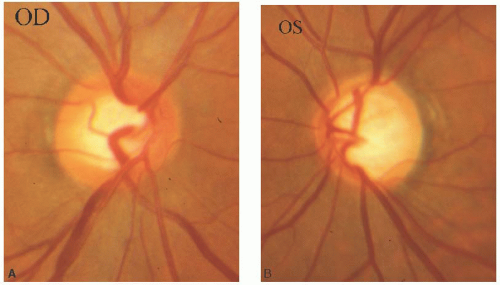 CASE 19, FIGURE 1 Optic disc photos: (A) right disc and (B) left disc. (Courtesy of Robert S. Feder, M.D.) |
Surgical Plan | |||
Right Eye | Left Eye | Comments | |
IntraLase diameter | 9.5 mm | No treatment | IntraLase preferred to create a reliably thinner flap with less IOP elevation |
IntraLase depth | 110 µm | None | Usually creates a 120-µm flap |
Ablation zone | 6.5 mm + blend zone 6.0 mm + blend acceptable | None | VISX STAR S4 |
Calculations with nomogram correction (enter into VISX) | -5.00 D × 6% = -0.30 D -5.25 + 0.30 D = -4.95 D -4.95 + 0.50 × 90° | ||
Ablation depth | -5.00 D ×15 µm/D = 75 µm | ||
RSB | 75 µm + 8 µm = 83 µm 513 µm – 120 µm – 83 µm = 310 µm >250 µm | Intraoperative pachymetry is recommended to determine RSB | |
1 | A complete eye examination is an important part of the LASIK evaluation. |
2 | Keratorefractive surgery may make glaucoma more difficult to manage because IOP measurement is unreliable and PRK haze may make fields unreliable; also, steroid-induced IOP elevation may be difficult to detect. |
3 | It is possible for IOP rise during flap creation to cause further damage to a nerve with extensive glaucomatous damage. |
W | OD – 4.50 + 0.50 × 90° 20/25+ OS – 4.75 + 0.75 × 90° 20/30 | Uncorrected Va OD 20/400 OS 20/400 |
M | OD – 4.75 + 0.50 × 90° 20/20 OS – 5.25 + 0.75 × 85° 20/20 | |
C | OD – 4.75 + 0.50 × 90° 20/20 OS – 5.25+ 0.75 × 90° 20/20 | |
K | OD 43.5 × 90°/43.0 × 180° OS 43.5 × 90°/42.5 × 180° | |
Pachymetry OD 475 µm OS 480 µm | Topography Regular astigmatism OU | Scotopic Pupils OD 6.5 mm OS 6.0 mm |
1 | Avoid LASIK on very thin corneas. Surface ablation or phakic IOL insertion may be a better long-term solution. |
2 | Consider MMC prophylaxis in higher myopic surface ablations, when the estimated ablation depth is 75 µm or greater. |
3 | Follow the MMC protocol for preparation and application meticulously. |
4 | Adjust the entered refraction according to the nomogram (see Chapter 13) to take into account the effect of MMC on wound healing. |
W | OD – 3.00 + 2.00 × 89° 20/40 OS – 3.25 + 1.75 × 100° 20/40 | Uncorrected Va 20/100 20/200 |
M | OD – 3.25 + 2.25 × 91° 20/40+2 OS – 3.00 + 2.00 × 95° 20/30-1 | |
WR | OD – 2.22 + 2.19 × 91° OS – 1.98 + 1.93 × 96° | |
C | OD – 2.75 + 2.25 × 90° 20/30- OS – 2.50 + 2.00 × 95° 20/30- | |
K | OD 42.00 × 180°/44.25 × 90° OS 41.75 × 188°/44.00 × 98° | |
Pachymetry OD 550 µm OS 557 µm | Topography No cone | Scotopic Pupils OD 5.9 mm OS 6.3 mm |
be difficult to center a microkeratome, because the eye is moving as suction is being applied. Finally, registration could be an issue. It is difficult to mark such a patient at the slit lamp for alignment with the laser. Accurate registration is an important step in any custom LASIK surgery or in conventional surgery to correct significant astigmatism.
Surgical Plan | |||
Right Eye | Left Eye | Comments | |
Ring diameter | 9.5 mm | 9.5 mm | Hansatome |
Plate thickness | 160 µm | 160 µm | Usually creates a 120-µm flap |
Ablation zone | 6.0 mm with transition to 8.0 mm | 6.0 mm with transition to 8.0 mm | VISX STAR S4 CustomVue |
No nomogram adjustment needed (enter into VISX) | -2.22 + 2.19 × 91° Physician adjustment of -0.50 D -2.72 + 2.19 × 91° | -1.98 + 1.93 × 96° Physician adjustment of -0.50 D -2.48 + 1.93 × 96° | Spherical portion can be adjusted ±0.75 D. In US cylinder, power and axis is fixed |
Ablation depth RSB | Low ablation depth with ample corneal thickness. RSB adequate OU | Low ablation depth with ample corneal thickness. RSB adequate OU | Ablation depth is calculated by WaveScan unit |
1 | Mild amblyopia, in and of itself, is not a contraindication to LASIK surgery, provided the patient has reasonable expectations. |
2 | Nystagmus can pose a problem for marking and registration, WaveScan acquisition, microkeratome centration, and laser tracking. |
3 | The patient should be evaluated before surgery to determine if the laser can track the eyes. A robust tracker can increase the safety of LASIK in the nystagmus patient. |
W | OD – 4.75 + 1.50 × 90° 20/20 OS – 5.50 + 1.75 × 90° 20/20 | Uncorrected Va 20/400 20/400 |
M | OD – 5.00 + 1.50 × 90° 20/15 OS – 6.00 + 2.00 × 90° 20/15 | |
C | OD – 4.75 + 1.75 × 90° 20/20 OS – 5.50 + 1.75 × 90° 20/20 | |
K | OD 43.50 × 180°/45.50 × 90° OS 43.75 × 178°/45.75 × 88° | |
Pachymetry OD 560 µm OS 557 µm | Topography With-the-rule astigmatism OU | Scotopic Pupils OD 6.0 mm OS 6.0 mm |
Surgical Plan | |||
Right Eye | Left Eye | Comments | |
Ring size | 0 | 0 | Moria CB |
Microkeratome head | 130 µm | 130 µm | Typically cuts 160-µm flap |
Ablation zone | 6.5 mm with blend zone | 6.5 mm with blend zone | VISX STAR S4 |
Cycloplegic Rx | -3.25 – 1.50 × 180° | -3.75 – 1.75 × 180° | Minus cylinder form |
Calculations using Dr. Rosenfeld’s nomogram correction (VISX) | -2.93 – 1.50 × 180° | -3.38 – 1.75 × 180° | 10% reduction of sphere using the cycloplegic examination in minus cylinder form |
Flap thickness | 160 µm | 160 µm | |
Ablation depth | 56 µm | 62 µm | |
RSB | 344 µm | 335 µm | >250 µm OU |
W | OD – 6.50 + 0.50 × 72° OS – 6.00 + 0.50 × 64° | Uncorrected Va 20/400- 20/400- |
M | OD – 6.75 + 0.50 × 110° 20/20 OS – 6.00 + 1.00 × 70° 20/20 with + 1.25 add → 20/20 near OU | |
C | OD – 6.75 + 0.25 × 120° 20/20 OS – 6.00 + 0.75 × 70° 20/20 | |
K | OD 45.50 × 90°/44.50 × 180° OS 46.50 × 77°/45.25 × 167° | |
Pachymetry OD 500 µm OS 495 µm | Topography +0.75 D × 90° OD +1.00 D × 77° OS | Scotopic Pupils OD 6.5 mm OS 6.5 mm |
lens-induced effects on the cornea. These include contact lens warpage, which can induce irregular astigmatism, masked astigmatism, and/or myopia that is hidden by the flattening effects of the rigid contact lens. The corneal maps must look smooth and regular and the principal astigmatic axes must be 90° apart. The magnitude and direction of the topographic astigmatism should closely match the refractive astigmatism, although there is usually 0.25 to 0.50 D more astigmatism seen on the maps compared to the refraction. Second, patients who are long-time rigid contact lens wearers have higher visual expectations than patients who wear soft lenses or spectacles. The rigid lenses mask any irregular astigmatism on the patient’s cornea and produce an artificially regular surface. These patients should be counseled that their postoperative vision may never be as good as their vision with their rigid lenses.
Surgical Plan | |||
Right Eye | Left Eye | Comments | |
Considerations | Do not perform LASIK if the cornea is too thin. Be sure that there are no effects from the rigid contact lens | ||
Ring size | None in PRK | None in PRK | Cornea too thin |
Plate size | None in PRK | None in PRK | Cornea too thin |
Ablation zone | 6.5 mm with blend | 6.5 mm with blend | Pupil = 6.5 mm OU |
Spherical equivalent | -7.50 D | -6.25 D | |
Conventional surface treatment based on manifest and cycloplegic refractions Treatment is entered in minus cylinder form | -6.75 + 0.50 D × 110° -6.25 – 0.50 × 20° | -5.75 + 0.75 D × 70° -5.00 – 0.75 × 160° | There is no nomogram adjustment with PRK |
Ablation depth | 120 µm | 98 µm | The Alcon software calculates the ablation depth |
RSB | 500 µm – 120 µm = 380 µm | 495 µm – 98 µm =397 µm | |
1 | Be sure the patient stays out of her rigid contact lenses until the refraction and topography become stable. The stable topography should be consistent with the refraction. |
2 | Warn patients in their mid-40s about the effect of myopic LASIK on presbyopia and discuss treatment options. Avoid monovision in patients who require excellent stereopsis to perform their jobs. |
3 | Avoid LASIK if the cornea is too thin. |
W | OD – 8.25 + 1.00 × 72° 20/30+ OS – 6.00 + 0.75 × 77° 20/30- | Uncorrected Va CF 3′ CF 3′ |
M | OD – 7.50 + 1.00 × 85° 20/25- OS – 5.50 + 0.75 × 85° 20/20- | |
C | OD – 7.50 + 1.00 × 90° 20/25+ OS – 5.50 + 0.75 × 85° 20/20- | |
K | OD 41.62 × 179°/43.25 × 89° OS 42.00 × 180°/42.87 × 90° | |
Pachymetry OD 556 µm OS 550 µm | Topography No evidence of ectasia OU | Scotopic Pupils OD 6 mm OS 6 mm |
1 | Blepharospasm is a risk factor for partial or incomplete flap intraoperatively. |
2 | Wearing a nighttime CPAP mask may increase the risk of both flap displacement and dryness. |
3 | Surface ablations deeper than 75 µm are more likely to develop stromal haze postoperatively. |
4 | The use of topical MMC 0.2 mg/mL may reduce the risk of postoperative stromal haze, but requires a 10% to 12% reduction in spherical myopic power. The use of MMC requires significant patient education. |
5 | Do not forget to calculate the postoperative corneal curvature in any high myopia patient to be certain the new corneal contour will not be <35.00 D, possibly too flat to support good visual function. |
6 | Warn the patient with a tropia about the possibility of diplopia postoperatively, if the ability to suppress the wandering eye is disturbed. |
7 | Make sure the myopic patient of presbyopic age being treated in both eyes for distance really understands the impact this will have on unaided near vision. |
history of prior ocular trauma, infection, or prior surgery. He takes no systemic or ocular medications, and has no known drug allergies. His refraction has been stable for more than 1 year.
W | OD – 4.50 + 0.50 × 90° 20/25 OS – 4.75 + 0.75 × 90° 20/30 | Uncorrected Va 20/400 20/400 |
M | OD – 4.75 + 0.50 × 90° 20/2° OS – 5.25 + 0.75 × 85° 20/20 | |
C | OD – 4.75 + 0.50 × 90° 20/20 OS – 5.25 + 0.75 × 90° 20/20 | |
K | OD 43.00 × 180°/43.50 × 90° OS 42.50 × 180°/43.50 × 90° | |
Pachymetry OD 475 µm OS 480 µm | Topography Regular bow-tie OU | Scotopic Pupils OD 6.5 mm OS 6.5 mm |
W | OD – 5.75 20/20 OS – 5.75 20/40+ (old R×) | Uncorrected Va OD CF OS CF |
M | OD – 6.75 20/20 OS – 6.25 + 1.50 × 35° 20/20- | |
C | OD – 6.25 20/15 OS – 6.00 + 1.50 × 45° 20/15- | |
K | OD 45.50 × 180°/45.50 × 90° OS 45.50 × 142°/46.50 × 52° | |
Pachymetry OD 529 µm OS 501 µm | Topography Preoperative: Case 26 Figures 1, 2, and 3 | Scotopic Pupils OD 6.0 mm OS 6.0 mm |
set of indices is foolproof in preventing postoperative ectasia. It is recommended that several indices and analyses be used to determine whether a particular patient is suitable for keratorefractive surgery. The risks should be carefully and completely explained to the patient and the discussion should be documented in the chart. Some surgeons have the patient sign the record to acknowledge an understanding of the unique risks in the specific case.
Surgical Plan: LASIK OD and PRK OS | |||
Right Eye | Left Eye | Comments | |
Ring size | 8.5 mm | N/A | K > 45.50 |
Plate size | 160 µm | N/A | Usually thinner flap occurs in thin corneas |
Ablation zone | 6.5 mm (alternatively, a 6.0-zone plus blend) | 6.5 mm (alternatively a 6.0-zone plus blend) | Pupils <6.0 mm |
Spherical equivalent | -6.25 D | -5.25 D | |
Calculations with nomogram correction (enter into VISX) | -6.25 × 6% = 0.375 -6.25 + 0.38 =-5.87 -5.87 | -6.00 + 1.50 × 45° | Some surgeons prefer to use the axis from the manifest refraction |
Ablation depth | 6.25 D × 15 µm/D = 94 µm | 5.25 D × 15 µm/D = 79 µm | The risk of haze may be increased, due to an ablation depth >75 µm |
RSB | 529 µm – 160µm – 94 µm = 275 µm >250 µm | 501 µm – 79 µm = 422 µm | This patient may require an RSB >300 or more to prevent ectasia |
1 | Reduced best-corrected acuity and significantly decreased central thickness relative to the fellow eye are signs that may be present in association with FFKC. |
2 | Review preoperative topography carefully for signs of KC or pellucid marginal degeneration (PMD). Different indices provided on most topography units can help determine the presence of subclinical KC, but may not detect PMD. |
3 | If corneal ectasia is present, the patient should not have corneal refractive surgery. If a patient does not seem to understand the risk that may be present in any case, do not do refractive surgery. |
4 | In borderline cases, PRK might be a better choice than LASIK to maximize the RSB. If the ablation depth is >75 µm, the use of topical MMC is a consideration to reduce the risk of haze. However, the long-term effects of MMC, particularly in cases such as this are not known. |
5 | Even when PRK is performed and the RSB is >300 µm, progressive ectasia may occur. |
W | OD + 3.25 20/20-3 OS + 3.50 20/25- | Uncorrected Va 20/30 18 pt 20/80 24 pt |
M | OD + 3.75 20/15 OS + 4.25 + 0.50 × 55° 20/20+ | |
C | OD + 4.50 20/15 OS + 5.50 + 0.50 × 60° 20/15 slow | |
K | OD 43.25 × 15°/44.00 × 105° OS 43.50 × 12°/44.00 × 102° | |
Pachymetry OD 544 µm OS 537 µm | Topography Regular with-the-rule astigmatism OU | Scotopic Pupils OD 5.0 mm OS 5.0 mm |
Surgical Plan | |||
Right Eye | Left Eye | Comments | |
Ring size | 9.5 mm | None for PRK | |
Plate size | 160 µm | None for PRK | Hansatome flap usually thinner than 160 µm |
Ablation zone | 9.0 mm | 9.0 mm | Hyperopic protocol |
Calculations with nomogram correction (enter into VISX) | +4.00 × 25% = 1.00 +4.00 + 1.00 = +5.00 +5.00 D | +5.50 + 0.50 × 60° | No nomogram adjustment for PRK OS |
Ablation depth | 5 D × 8 µm/D = 40 µm | 5.75 D × 8 µm/D = 46 µm | |
RSB | 544 µm – 160 µm – 40 µm = 344 µm >250 µm | 537 µm – 160 µm – 46 µm = 331 µm >250 µm | Hyperopic ablation is not deepest centrally, so RSB is significantly >250 µm |
1 | If the manifest and cycloplegic refractions are significantly different, explain this to the patient and help the patient adapt to a correction similar to the cycloplegic before surgery. |
2 | BPRK on the VISX STAR S4 does not require a nomogram adjustment and this can allow an appropriate large treatment to be done within the approved range. |
3 | Calculate an expected postsurgical keratometry value by adding the spherical equivalent of the proposed treatment in diopters to the average keratometry. The expected postoperative keratometry (allowing some room for retreatment) should ideally be >35.00 D and <50.00 D. Remember that for myopia the conversion factor for calculating the expected postoperative keratometry is 0.7 or 0.8 multiplied by the spherical equivalent added to the average keratometry. |
W | OD + 3.00 20/25+ OS + 2.75 + 0.50 × 90° 20/15 Add + 2.75 OU | Uncorrected Va 20/100 18 pt @ 14′ 20/100 18 pt @ 14′ |
M | OD + 3.25 20/20- OS + 3.50 20/15 | |
C | OD + 3.00 20/20 OS + 3.50 20/15 | |
K | OD 43.75 × 180°/43.75 × 90° OS 44.00 × 180°/44.25 × 90° | |
Pachymetry OD 551 µm OS 551 µm | Topography Regular astigmatism OU | Scotopic Pupils OD 4.0 mm OS 4.0 mm |
Surgical Plan | |||
Right Eye | Left Eye | Comments | |
Ring size | 9.5 mm | 9.5 mm | Large flap required for hyperopic LASIK |
Plate size | 160 or 180 µm | 160 or 180 µm | Hansatome |
Ablation zone | Hyperopic LASIK profile | Hyperopic LASIK profile | VISX STAR S4 |
Cycloplegic refraction used for treatment | +3.00 D | +3.50 D | Make sure full cycloplegia |
Calculations using the hyperopic nomogram correction (see Table 7.2, page 77) (enter into VISX) | +3.00 × 30% = 0.90 +3.00 + 0.9 = +3.90 +3.90 D | +3.50 + 30% = 1.05 +3.50 + 1.05= +4.55 +4.55 D | Increase the correction to compensate for the expected postoperative regression; +4.55 D is close to the maximum +5.00 D approved for VISX |
Ablation depth | 3.9 D × 8 µm/D = 31 µm | 4.55 D × 8 µm/D = 36 µm | Deepest ablation, 8 µm/D, occurs in a 5-mm diameter ring around the center of the ablation zone |
RSB | 551 µm – 160 µm – 31 µm = 360 µm | 551 µm – 160 µm -36 µm = 354 µm | Hyperopic ablation is not deepest centrally, so RSB is significantly greater |
1 | Remember both the psychosocial as well as the anatomical criteria for LASIK surgery. |
2 | Pretreatment with 1 mL of atropine 0.4 mg/mL by intramuscular injection can help prevent a vasovagal reaction. May also be necessary for retreatment. |
3 | Significant anemia is a risk factor for ischemic injury related to increased IOP from the suction ring. |
4 | Overcorrection is necessary to compensate for the postoperative regression that often occurs with hyperopic LASIK. |
5 | Hyperopic patients need to be educated about the possible need for distance glasses after surgery and that it may take up to 6 months for the refraction to stabilize. |
W | OD + 3.50 sph 20/25- OS + 3.75 sph 20/25- | Uncorrected Va 20/100 20/200 |
M | OD + 4.00 + 0.55 × 60° 20/20-1 OS + 4.00 + 0.75 × 127° 20/20 | |
WR | OD + 4.17 + 0.65 × 55° OS + 3.74 + 0.73 × 141° | |
C | OD + 4.25 + 0.50 × 60° 20/20 OS + 4.00 + 0.62 × 130° 20/20 | |
K | OD 40.62 × 147°/41.12 × 57° OS 40.12 × 45°/40.87 × 135° | |
Pachymetry OD 562 µm OS 570 µm | Topography Regular astigmatism OU | Scotopic Pupils OD 7.5 mm OS 7.2 mm |
microkeratome should be used. The femtosecond laser is an excellent alternative because the flap diameter created is independent of corneal curvature.
Manifest Refraction | Uncorrected Va |
OD -1.25 + 0.25 × 90° 20/20 | 20/50 |
OS -0.75 + 0.50 × 75° 20/20 | 20/30 |
1 | Low hyperopia cases treated with CustomVue typically end up near plano postoperatively, but high hyperopic cases may be prone to overcorrection. This may be related to the longer treatment time. |
2 | Careful clinical correlation of manifest and wavefront refractions is extremely important in treating hyperopic patients. |
3 | Avoid cases when the estimated average postoperative keratometry is >50.00 D. |
4 | If the preoperative cornea is flat, use a large microkeratome ring or femtosecond laser. |
W | OD + 2.50 + 1.25 × 94° 20/25- OS + 3.75 + 1.50 × 86° 20/30 | Uncorrected Va CF distance; 18 pt near CF distance; 18 pt near |
M | OD + 3.00 + 1.25 × 90° 20/15 OS + 4.75 + 2.00 × 85° 20/20 | |
C | OD + 3.00 + 1.50 × 90° 20/15 OS + 5.00 + 2.00 × 85° 20/20 | |
K | OD 41.50 × 6/42.75 × 96° OS 41.75 × 178/42.75 × 88° | |
Pachymetry OD 505 µm OS 501 µm | Topography Regular astigmatism OU | Scotopic Pupils OD 7.0 mm OS 7.0 mm |
Surgical Plan | |||
Right Eye | Left Eye | Comments | |
Ring size for LASIK | 8.5 mm | 9.0-mm epithelial debridement | Steep small cornea; 8.5-mm ring is the better choice OD |
Plate size for LASIK | 160 µm or 180 µm | Not applicable | Thin flaps result from mechanical microkeratome flaps in thin corneas |
Ablation zone | 9.0 mm | 9.0 mm | VISX STAR S4 |
Spherical equivalent | +3.75 D | +6.00 D | |
Calculations with nomogram correction | +3.75 × 23% = 0.86 +3.00 + 0.86 = +3.86 | +6.00 × 28% = +1.68 +5.00 + 1.68= +6.68 (see comment) | +6.68 (sphere + nomogram adjustment) exceeds the FD-Aapproved limit. With PRK, treat on cycloplegic refraction |
(enter into VISX) | +3.86 + 1.50 × 90° | +5.00 + 2.00 × 85° | |
Ablation depth | 4.61 D × 8 µm/D = 37 µm | 6.00 D × 8 µm/D = 48 µm | |
RSB | 505 µm – 160 µm – 37 µm = 308 µm >250 µm | 501 µm – 160 µm – 48 µm = 293 µm >250 µm | Hyperopic ablation is not deepest centrally, so RSB is greater |
1 | If the spherical equivalent plus the nomogram adjustment exceeds the approved limit for the laser, consider using PRK, which does not require a nomogram adjustment. |
2 | Explain to patients that at the extremes of approved hyperopic treatment, a loss of best-corrected postoperative visual acuity can occur. |
3 | Clear lens extraction with a toric IOL to correct astigmatism, a multifocal IOL (provided both eyes will ultimately be treated), or an accommodating IOL with LRI are additional options when the amount of hyperopic correction is excessive. |
W | OD – 4.50 20/20-3 OS + 3.00 + 1.25 × 30° 20/20+ | Uncorrected Va OD CF OS 20/400 |
M | OD – 4.75 20/15 OS + 3.00 + 0.75 × 40° 20/20+ | |
C | OD – 4.50 + 0.50 × 175° 20/15- OS + 3.00 + 0.75 × 40° 20/20± | |
K | OD 44.75 × 15°/ 45.00 × 175° OS 37.12 × 12°/38.50 × 102° | |
Pachymetry OD 510 µm OS 498 µm (≥537 µm in midperiphery) | Topography Regular OD Central flattening OS | Scotopic Pupils OD 5 mm OS 5 mm |
Surgical Plan | |||
Right Eye | Left Eye | Comments | |
Ring size | IntraLase 9.0-mm flap diameter in case retreatment needed | 9.5 mm | Preoperative K < 45.00 D |
Plate size | IntraLase 110-µm flap depth, usually creates a flap not greater than 120 µm | 180 µm | Hansatome flap in a thin cornea can be quite thin. Very thin flap after RK is a disadvantage |
Ablation zone | 6.0 mm | 9.0 mm | Hyperopic protocol OS |
Calculations with nomogram correction (enter into VISX) | -4.25 D × 9% = 0.38 -4.50 + 0.38 = -4.12 -4.12 + 0.50 × 175 | +3.00 + 0.75 × 40° See Table 7.2 for nomogram adjustment +3.375 × 2% = 0.07 +3.07 + 0.75 × 40° | +2% nomogram adjustment for a 66-year-old with consecutive hyperopia after RK |
Ablation depth | 4.25 D × 12 µm/D = 51 µm | 3.445 D × 8 µm/D = 28 µm | Spherical equivalent × appropriate conversion |
RSB | 510 µm – 120 µm – 51 µm = 339 µm >250 µm | 498 µm – 180 µm -28 µm = 290 µm >250 µm | RSB OS likely >291 µm because flap likely to be thinner than 180 µm and hyperopic treatment is not deepest centrally |
1 | LASIK can safely be done following RK if there is no more than minimal irregular astigmatism, thin well-healed scars, and no large epithelial plugs. |
2 | The microkeratome should be used rather than the femtosecond laser, with the ring size based on the preoperative keratometry. |
3 | Should the flap separate, carefully replace the pieces after the excimer ablation has been completed and place a bandage contact lens on the eye. |
4 | The suggested nomogram adjustment for consecutive hyperopia following RK is considerably different than for treatment of primary hyperopia (see Table 7.2). A reduction rather than an addition to treatment may be required for patients under 50. |
W | OD + 2.25 20/25 OS + 2.00 20/25 | Uncorrected Va 20/200 20/200 |
M | OD + 2.25 + 1.00 × 25° 20/20- OS + 2.00 + 1.00 × 160° 20/20- | |
C | OD + 2.25 + 1.00 × 30° 20/20- OS + 2.25 + 1.00 × 164° 20/20- | |
K | OD 41.00 × 112°/41.75 × 22° OS 40.87 × 70°/41.50 × 160° | |
Pachymetry OD 534 µm OS 536 µm | Topography Regular astigmatism OU | Scotopic Pupils OD 5.0 mm OS 5.0 mm |
Surgical Plan | |||
Right Eye | Left Eye | Comments | |
PRK OU | |||
Ablation zone | 9.0 mm | 9.0 mm | VISX STAR S4 |
Enter into VISX | +2.25 + 1.00 × 25° | +2.25 + 1.00 × 160° | No nomogram adjustment needed for hyperopic treatment |
Ablation depth | +2.75 D × 8 µm/D = 22 µm | +2.75 D × 8 µm/D = 22 µm | Low risk of central haze |
Stay updated, free articles. Join our Telegram channel

Full access? Get Clinical Tree



